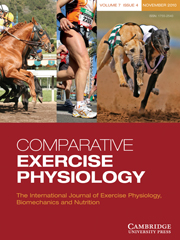Article contents
Innovative exercise device that simulates horseback riding: cardiovascular and metabolic responses
Published online by Cambridge University Press: 01 February 2008
Abstract
An innovative exercise machine, which mimics the movement of horseback riding, has been made available in the market. As an initial step in characterizing this device, we determined the cardiovascular and metabolic responses to exercise. Twenty apparently healthy subjects rode the device (Equus) on day 1. The upper body exercises were added on day 2, to see whether cardiac and metabolic demands were further elevated (Equus+aerobics). After 10 min of continuous exercise, oxygen consumption increased significantly. In the Equus+aerobics condition, increase in oxygen consumption was significant as early as 4 min into the graded exercise test. Overall oxygen consumption was greater in the Equus+aerobics condition than in the Equus condition (P < 0.05). Oxygen consumption returned to baseline levels within 1 h after the Equus (190 ± 58–188 ± 50 ml min− 1) and Equus+aerobics (198 ± 54–194 ± 43 ml min− 1) conditions. Heart rates increased gradually during the graded exercise tests in both conditions (64 ± 11–78 ± 15 and 65 ± 11–83 ± 12 bpm in the Equus and Equus+aerobics conditions, respectively). Both systolic and diastolic blood pressure (BP) increased significantly 6 min into the graded exercise tests and remained elevated throughout exercise in both the conditions. There were no significant differences in BP responses between the two conditions. These results indicate that the cardiac and metabolic stresses achieved with this exercise device are small.
- Type
- Short Communication
- Information
- Copyright
- Copyright © Cambridge University Press 2008
References
- 3
- Cited by


